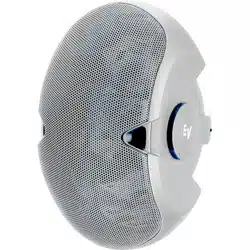Loading ...
Loading ...
Loading ...

EVID
TM
Owner’s Manual
12
Appendix A: Integrating the Subwoofer
Installation Examples
The EVID™ Series is a product family with
the flexibility to fit the requirements of
many different applications. Listed below
are some suggested combinations for
systems using the 12.1.
• Rich, full-sounding low-level background
music and paging in a quiet restaurant,
office, or retail space: two EVID™ 3.2s
in parallel on each output of a 12.1.
• Moderate-level music and paging in a
sports bar/restaurant or upbeat retail
space: two EVID™ 4.2s in parallel on
each output of a 12.1.
• Higher-level foreground music in bass-
heavy applications such as dance floors,
amusement arcades, or loud bars: use
one EVID™ 6.2 on each output of 12.1.
EVID™ systems may be used together.
For example, a large hotel might use eight
3.2s and two 12.1s in the dining room,
eight 4.2s and two 12.1s in the lounge,
four 6.2s with two 12.1s surrounding the
dance floor, 6.2s around the pool, 6.2s or
4.2s with or without 12.1s in the lobby, and
3.2s in the corridors.
Crossover Frequency and
Impedance
The EVID™ 12.1 is designed to be used
as a passive subwoofer. No additional
amplifiers or signal processors are
required to achieve full benefit of the
12.1's performance. The built-in passive
stereo crossover sends the lowest notes
of both stereo channels to the 12" dual-coil
bass driver and reduces the amount of low
frequencies sent to the satellite speakers.
This allows them to play louder and
cleaner while presenting a more even,
amplifier-friendly impedance load than if all
the speakers were connected in parallel.
The EVID™ 12.1's crossover tunes a
combination of electrical and acoustic
characteristics to complement the
response of the full-range EVID™ models.
The crossover point is set electrically in
the 160Hz range with a topology that
enables the nominal system impedance to
be determined by the number of satellites
per channel.
Using a Separate Amplifier
Channel for the 12.1
In certain specialized applications, it may
be desirable to drive the subwoofer with a
separate amplifier channel. In these
applications the active crossover point
must be at or below 160Hz so as not to
interfere with the built-in passive cross-
over. Both sections (left and right inputs)
must be connected in parallel (4 ohm
system impedance) when operating as a
mono device. No load resistors are
necessary on the hi-pass outputs.
Characteristics of All
Subwoofers
While subwoofers do radiate sound
omnidirectionally (in all directions) and the
sound is generally non-localizable (one
can't hear exactly where it comes from),
subwoofer sound level still drops off the
farther one moves from the subwoofer.
The highest output and best room loading
are accomplished with the subwoofer
mounted in a corner at a three-boundary
junction (wall/wall/ceiling or wall/wall/floor,
an arrangement also referred to as 1/8
space). Mounting at a two-boundary
junction (wall/ceiling, or 1/4 space)
produces three dB less output, and
mounting in the middle of a room in the
ceiling (1/2 space) reduces output still
another three dB.
Subwoofers produce large amounts of
long-wavelength low-frequency energy.
Every object has its own resonant
frequency, and long wavelengths tend to
excite large objects (like walls, floors,
doors and ceiling panels). Anything loose
in or on a ceiling or wall will buzz or rattle
as a subwoofer's level is increased. Most
of these can be isolated and fixed with
small, strategically placed bits of foam
tape. Others may require driving additional
nails or screws and perhaps some
caulking to dampen their sympathetic
movement. Be aware that as bass levels
increase, so does the likelihood of rattles
and buzzes.
Loading ...
Loading ...
Loading ...
